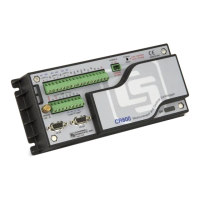Section 8. Operation
286
Unless a Calibrate() instruction is present in the running CRBasic program, the
CR800 automatically performs self-calibration during spare time in the
background as an automatic slow sequence
(p. 138), with a segment of the
calibration occurring every 4 seconds. If there is insufficient time to do the
background calibration because of a scan-consuming user program, the CR800
will display the following warning at compile time: "Warning when Fast Scan x is
running background calibration is disabled".
The composite transfer function of the instrumentation amplifier, integrator, and
analog-to-digital converter of the CR800 is described by the following equation:
COUNTS = G * Vin + B
where COUNTS is the result from an analog-to-digital conversion, G is the
voltage gain for a given input range, and B is the internally measured offset
voltage.
Automatic self-calibration only calibrates the G and B values necessary to run a
given CRBasic program, resulting in a program dependent number of self-
calibration segments ranging from a minimum of 6 to a maximum of 91. A typical
number of segments required in self-calibration is 20 for analog ranges and 1
segment for the panel temperature measurement, totaling 21 segments. So, (21
segments) * (4 s / segment) = 84 s per complete self-calibration. The worst-case is
(91 segments) * (4 s / segment) = 364 s per complete self-calibration.
During instrument power-up, the CR800 computes calibration coefficients by
averaging ten complete sets of self-calibration measurements. After power up,
newly determined G and B values are low-pass filtered as follows.
Next_Value=(1/5)*New+(4/5)*Old
This results in
• 20% settling for 1 new value,
• 49% settling for 3 new values
• 67% settling for 5 new values
• 89% settling for 10 new values
• 96% settling for 14 new values
If this rate of update for measurement channels is too slow, the Calibrate()
instruction can be used. The Calibrate() instruction computes the necessary G
and B values every scan without any low-pass filtering.
For a VoltSe() instruction, B is determined as part of self-calibration only if the
parameter MeasOff = 0. An exception is B for VoltSe() on the ±2500 mV input
range with 250 μs integration, which is always determined in self-calibration for
use internally. For a VoltDiff() instruction, B is determined as part of self-
calibration only if the parameter RevDiff = 0.
VoltSe() and VoltDiff() instructions, on a given input range with the same
integration durations, utilize the same G values but different B values. The 6
input-voltage ranges (±5000 mV, ±2500 mV, ±250 mV, ±25 mV, ±7.5 mV, ±2.5
mV) along with the three different integration durations (250 μs, 50-Hz half-
cycle, and 60-Hz half-cycle) result in a maximum of 18 different gains (G), and
18 offsets for VoltSe() measurements (B), and 18 offsets for VoltDiff()

